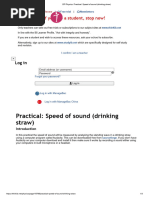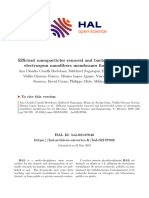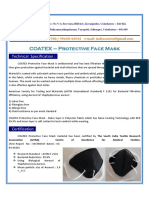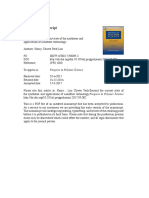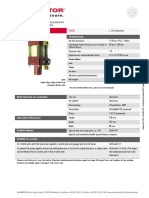Portrate
Uploaded by
Alex KhuzamPortrate
Uploaded by
Alex KhuzamAdvanced Materials and Manufacturing Technology
SRN: 22020983-Abdul Basit
ABSTRACT
Post-COVID-19, the world is at risk from airborne viral particles released by infected individuals. These aerosols range from 0.25-1 micrometers in, the use of face masks or respirators based Nanofiber PPE
represents a significant advancement, providing exceptional filtration efficiency and improved breathability. These products feature a complex network of nanofibers designed to capture and neutralize airborne
pathogens, including COVID-19. The effectiveness of these nanofibers is due to the combination of physical and electrostatic forces and their high surface area-to-volume ratio, which allows them to trap very
small viral particles. Nanofiber masks and respirators are becoming crucial in public health protection, offering strong defense against COVID-19. The use of nanotechnology in PPE marks a new chapter in
maintaining safety during challenging times, with nanofiber materials expected to bring significant benefits in the production of face masks and respirators.
• INTRODUCTION
After the COVID-19 pandemic, the world faces significant biological risks due to the viral airborne particles resulting from the person carrying the
virus,
these patients release small aerosol particles with diameters ranging between 0.25-1 micrometers, the size and shape of the particles that transmit
the virus into the air differ
when a person carrying the infection sneezes, coughs, or exhales
During a sneeze the patient’s spray contains approximately 40,000 droplets, which can reach speeds of up to 100 meters per second.
The dimensions of the virus fall within a spectrum of 80 to 150 nanometers, as depicted in the figure1[1], The concern arises from the virus’s
diminutive size,
which might enable it to penetrate through respirator filters that are designed to block particles larger than (0.3) micrometers.
Figure 1: Covid-19 [1]
• Nanofiber-based face masks and respirators
represent a paradigm shift in the field of personal protective equipment (PPE), offering unparalleled filtration efficiency coupled with enhanced breathability.
Engineered with precision, these marvels of modern engineering exhibit a labyrinthine network of nanofibers, meticulously crafted to
intercept and neutralize airborne pathogens, including the elusive COVID-19 virus
The fundamental principle underlying the efficacy of nanofiber-based filtration lies in the intricate interplay of physical and electrostatic forces.
At the nanoscale, these materials exhibit a vast surface area-to-volume ratio, amplifying their capacity to
ensnare even the minutest viral particles with unparalleled efficiency [2].
nanofiber-based face masks and respirators emerge as potent allies, offering a potent defense against the relentless onslaught of the COVID-19
the integration of cutting-edge nanotechnology into our arsenal of protective measures heralds a new era of resilience and fortitude in the face of adversity.
Employing nanofiber in the production of face masks and respirators for COVID-19 protection is expected to yield numerous advantages,
4- 6-
2- Improved Customized Sustainable
1-Enhanced Breathability 3- Enhanced Design and and Eco-
5-
Filtration Durability Functionality Friendly
Antimicrobial
Efficiency and
Properties
Longevity Figure 2: Nanofiber
Global standards adopted in the development of face masks and respirators
Face masks and respirators must adhere to certain standards and regulations that vary by country or region. There are five recognized performance criteria for
the materials used in the manufacture of medical masks, which include: fluid resistance, breathability, bacteria filtration efficiency (BFE), particle filtration
efficiency (PFE), and ignition. Per the European standard EN 14683, air-filtering respirators are categorized into three types: Type I respirators are required to
have a bacterial filtration efficiency of over 95%, Type II respirators must exceed 98% bacterial filtration efficiency, and Type IIR respirators not only need to
Manufacturing method
surpass 98% bacterial filtration efficiency but also be splash-resistant. Additionally, the standard mandates a resistance test for Type IR and Type IIR, with Type
IIR offering the highest level of resistance. [6-7]
Contemporary respirators utilize fiber filters comprising multiple strata of fine, flat fibers
capable of ensnaring particulates via physical adhesion barriers. The efficacy of filtration
Design Economic cost is governed by several parameters, including the diameter of the fibers, their tolerance,
and the thickness of the filter.
Nano fiber-based materials are often more durable and resistant to The filtration mechanism plays a crucial role in determining the precision and efficiency
degradation over time compared to conventional materials. This of the filtration media.
means that while the initial investment might be slightly higher, the Particulates are primarily sieved through five distinct mechanisms: (1) interception, (2)
longer lifespan of Nano fiber-based masks can make them more cost- inertial impaction, (3) diffusion, (4) gravitational settling, and (5) electrostatic attraction.
effective in the long run, Overall, while Nano fiber-based face masks For the execution of a profound and highly efficient filtration operation within a
and respirators may offer superior performance and durability condensed timeframe, the employment of velvet nanofiber is advocated. [9],
compared to traditional options, their economic cost may be higher Electrostatic spinning represents an innovative approach to nanofiber production, During
due to factors such as specialized manufacturing processes and the electrospinning process, a substantial electrical potential is administered to droplets
materials. However, advancements in technology, economies of scale, of molten material or polymer solution, mitigating the surface tension and facilitating the
and increased market competition could lead to reduced costs over formation of ultrafine fibers, whose diameters span from (40) to (2000) nanometers
time (figure 4).
making Nano fiber-based protective equipment more economically Selecting the optimal concentration of the solution, electrical voltage, and the gap
viable for widespread use, at present, for a unit of bio-functional between the collector device and the spinneret is vital for producing consistent
system the cost is approximately 12000$ while it is about 7000$ for nanofibers. Nanofiber-based filtration media, being integral to this technology, play a
more traditional system. pivotal role in augmenting the efficacy of filtration [10-11].
Figure 3: face mask structure [8]
• SUMMARY
The COVID-19 pandemic, one of the gravest challenges of this
century, has significantly heightened the demand for high-quality
medical air filters to bolster preventive measures and curb the
virus’s proliferation. Nanotechnology stands at the forefront of this
battle, offering sophisticated manufacturing methods to create
Nano filters that effectively sieve out viral particles. These
nanotechnology-derived filters, produced through electrospinning,
enhance filtration performance sustainably for both face masks
and respirators, despite their current manufacturing costs being
Figure 4: Electros pinning processing [11] higher than those of conventional systems.
• REFERENCES
1-Ruiz-Hitzky, E.; Darder, M.; Wicklein, B.; Ruiz-Garcia, C.; Martín-Sampedro, R.; del Real, G.; Aranda, P, 2020, Nanotechnology Responses to COVID-19. Adv. Health. Mater., 9, 2000979.
2-Wang, N.; Yang, Y.; Al-Deyab, S.S.; El-Newehy, M.; Yu, J.; Ding, B,2015, Ultra-light 3D nanofiber-nets binary structured nylon6–polyacrylonitrile membranes for efficient filtration of fine particulate matter. J. Mater. Chem, 23946–23954
3-Xu, J.; Liu, C.; Hsu, P.-C.; Liu, K.; Zhang, R.; Liu, Y.; Cui, Y. Roll-to-roll transfer of electro spun nanofiber film for high-efficiency transparent air filter. Nano Lett. 2016, 16, 1270–1275
4-Bian, Y.; Wang, R.; Wang, S.; Yao, C.; Ren, W.; Chen, C.; Zhang, L, 2018, Metal–organic framework-based nanofiber filters for effective indoor air quality control. J. Mater. Chem. 6, 15807–15814
5-Al-Attabi, R.; Morsi, Y.; Schütz, J.A.; Cornu, D.; Maghe, M.; Dumée, L.F, 2021, Flexible and reusable carbon nanofiber membranes for airborne contaminants capture. Sci. Total Environ., 754, 142231.
6-Bałazy, A.; Toivola, M.; Adhikari, A.; Sivasubramani, S.K.; Reponen, T.; Grinshpun, S.A, 2006, Do N95 respirators provide 95% protection level against airborne viruses, and how adequate are surgical masks? Am. J. Infect. Control, 34, 51–57.
7-Shorten, G.D, 2020, Personal protective equipment during the COVID-19 pandemic (Letter #1). Can. J. Anish. 67, 1647–1648
8-Fang, J.; Zhang, L.; Sutton, D.; Wang, X.; Lin, T, 2012, Needleless Melt-Electrospinning of Polypropylene Nanofibers. J. Nanomater, 382639.
9-Abdelrazeq, H.; Khraisheh, M.; Al Momani, F.; McLeskey, J.T.; Hassan, M.K.; Gad-el-Hak, M.; Tafreshi, H.V, 2020, Performance of electro spun polystyrene membranes in synthetic produced industrial water using direct-contact membrane distillation. Desalination, 493, 114663.
10-Abbas, J.A.; Said, I.A.; Mohamed, M.A.; Yasin, S.A.; Ali, Z.A.; Ahmed, I.H, 2018, Electrospinning of polyethylene terephthalate (PET)nanofibers: Optimization study using touchy design of experiment. IOP Conf. Ser. Mater. Sci. Eng. 454, 012130
11-Wafa K. Essa, Suhad A. Yasin, Ibtisam A. Saeed, Gomaa A. M. Ali,2021, Nanofiber-Based Face Masks and Respirators as COVID-19 Protection, MDPI, Switzerland, https://doi.org/10.3390/membranes11040250
You might also like
- DP Physics - Practical - Speed of Sound (Drinking Straw)No ratings yetDP Physics - Practical - Speed of Sound (Drinking Straw)3 pages
- Biodegradable, Efficient, and Breathable Multi-Use Face Mask FilterNo ratings yetBiodegradable, Efficient, and Breathable Multi-Use Face Mask Filter8 pages
- Sciencedirect: Electrospun Nanofibers For Air Filtration ApplicationsNo ratings yetSciencedirect: Electrospun Nanofibers For Air Filtration Applications5 pages
- Nano Membrane Fibrous On Lyocell Non-Woven FabricNo ratings yetNano Membrane Fibrous On Lyocell Non-Woven Fabric3 pages
- A Review On Recent Trends of Antiviral Nanoparticles and Airborne Flters - Special Insight On COVID 19 VirusNo ratings yetA Review On Recent Trends of Antiviral Nanoparticles and Airborne Flters - Special Insight On COVID 19 Virus14 pages
- A Review of Processing Strategies For Producing Micro Nano Fibres For High Efficiency FiltrationNo ratings yetA Review of Processing Strategies For Producing Micro Nano Fibres For High Efficiency Filtration44 pages
- Alenezi2020 Article ANovelReusableAnti-COVID-19TraNo ratings yetAlenezi2020 Article ANovelReusableAnti-COVID-19Tra9 pages
- Industrial Engineering: Submitted To: Asst. Professor Nandkishore BaraikNo ratings yetIndustrial Engineering: Submitted To: Asst. Professor Nandkishore Baraik16 pages
- White and Purple Simple Research Proposal PresentationNo ratings yetWhite and Purple Simple Research Proposal Presentation22 pages
- Mask - Material - Challenges - and - Virucidal - Properties - Nanoselulosa Dan GrapheneNo ratings yetMask - Material - Challenges - and - Virucidal - Properties - Nanoselulosa Dan Graphene14 pages
- Development of Functional Filter Materials for Virus Protective Face MasksNo ratings yetDevelopment of Functional Filter Materials for Virus Protective Face Masks10 pages
- Can N95 Respirators Be Reused After Desinfection-How Many TimesNo ratings yetCan N95 Respirators Be Reused After Desinfection-How Many Times9 pages
- Roll-to-Roll Transfer of Electrospun Nanofiber Film For HighEfficiency Transparent Air FilterNo ratings yetRoll-to-Roll Transfer of Electrospun Nanofiber Film For HighEfficiency Transparent Air Filter6 pages
- Title: Customized and Reusable Antimicrobial/Antiviral 3D Printed Respirator Inventors: Company Copper3D IncNo ratings yetTitle: Customized and Reusable Antimicrobial/Antiviral 3D Printed Respirator Inventors: Company Copper3D Inc7 pages
- Manikin-Based Performance Evaluation of N95 Filtering-Facepiece Respirators Challenged With NanoparticlesNo ratings yetManikin-Based Performance Evaluation of N95 Filtering-Facepiece Respirators Challenged With Nanoparticles16 pages
- Beyond The Current State of The Syntheses and Applications of Nanofiber TechnologyNo ratings yetBeyond The Current State of The Syntheses and Applications of Nanofiber Technology57 pages
- Biomimetics and Bio-Inspired Nanotechnology To Control COVID-19No ratings yetBiomimetics and Bio-Inspired Nanotechnology To Control COVID-198 pages
- 6 Emerging Nanofibrous Air Filters For PM Removal: 6.1 Particulate MatterNo ratings yet6 Emerging Nanofibrous Air Filters For PM Removal: 6.1 Particulate Matter30 pages
- Applied Materials Today, 2019, 17, 1-35No ratings yetApplied Materials Today, 2019, 17, 1-35101 pages
- Nanotechnology-Based Disinfectants and Sensors For Sars-Cov-2No ratings yetNanotechnology-Based Disinfectants and Sensors For Sars-Cov-24 pages
- Patent Application Publication (10) Pub. No.: US 2016/0015098 A1100% (1)Patent Application Publication (10) Pub. No.: US 2016/0015098 A124 pages
- Jun9 COVID Mask Acsbiomaterials.1c00368No ratings yetJun9 COVID Mask Acsbiomaterials.1c0036812 pages
- Progress on the Fabrication and Application of Electrospun Nanofiber CompositesNo ratings yetProgress on the Fabrication and Application of Electrospun Nanofiber Composites34 pages
- TDB #171 - Nanotechnology and Respirator UseNo ratings yetTDB #171 - Nanotechnology and Respirator Use5 pages
- Graphene-Based Technologies For Tackling COVID-19 UKNo ratings yetGraphene-Based Technologies For Tackling COVID-19 UK13 pages
- Nanofiber Nonwovens: Raghavendra R Hegde, Atul Dahiya, M. G. KamathNo ratings yetNanofiber Nonwovens: Raghavendra R Hegde, Atul Dahiya, M. G. Kamath9 pages
- Covid-19 Face Masks A Potential Source of Microplastic Fibers in The EnvironmentNo ratings yetCovid-19 Face Masks A Potential Source of Microplastic Fibers in The Environment4 pages
- N95s - Sufficient Protection For Covid19?: HereNo ratings yetN95s - Sufficient Protection For Covid19?: Here2 pages
- Nanohack: Copper3D Inc. Unetech Biomedical Incubator, 3929 Haney Street, Omaha, Ne 68105, UsaNo ratings yetNanohack: Copper3D Inc. Unetech Biomedical Incubator, 3929 Haney Street, Omaha, Ne 68105, Usa2 pages
- Possible Alternatives To Surgical N95 Respirators (In The United States and Canada) : HealthcareNo ratings yetPossible Alternatives To Surgical N95 Respirators (In The United States and Canada) : Healthcare4 pages
- Covid-19 Has Designers Reimagining Personal Protective EquipmentNo ratings yetCovid-19 Has Designers Reimagining Personal Protective Equipment4 pages
- Association of American Physicians and SurgeonsNo ratings yetAssociation of American Physicians and Surgeons6 pages
- Advances in Air Filtration Technologies - Structure-Based andNo ratings yetAdvances in Air Filtration Technologies - Structure-Based and13 pages
- Viavi Aeroflex RF Expansion Module RFEM Specification SheetNo ratings yetViavi Aeroflex RF Expansion Module RFEM Specification Sheet4 pages
- CBSE Sample Paper For Class 11 Physics Mock Paper 2 With SolutionsNo ratings yetCBSE Sample Paper For Class 11 Physics Mock Paper 2 With Solutions26 pages
- Railway Turning: Re-Turning and New Wheel TurningNo ratings yetRailway Turning: Re-Turning and New Wheel Turning50 pages
- Comparison of Actions and Resistances in Different Building Design CodesNo ratings yetComparison of Actions and Resistances in Different Building Design Codes12 pages
- Polyetheretherketone (PEEK) Is A PolyaromaticNo ratings yetPolyetheretherketone (PEEK) Is A Polyaromatic4 pages
- Presenter Notes SEL Confidential: Innovative Generator ProtectionNo ratings yetPresenter Notes SEL Confidential: Innovative Generator Protection45 pages
- Design of The Lightweight Structure Inspired by Beetle Elytra and Its Mechanical and Thermal PropertiesNo ratings yetDesign of The Lightweight Structure Inspired by Beetle Elytra and Its Mechanical and Thermal Properties8 pages
- Amankrah Kojo Asare - Finite Element Assessment of Precast Concrete Slab Using Ansys Structural - 2015No ratings yetAmankrah Kojo Asare - Finite Element Assessment of Precast Concrete Slab Using Ansys Structural - 201593 pages
- Topic: Projectile Motion at An Angle Worksheet 3No ratings yetTopic: Projectile Motion at An Angle Worksheet 39 pages
- Product Datasheet: Control Unit Micrologic 2.0 E, For Masterpact NT/NW Circuit Breakers, Fixed, LI Protections100% (1)Product Datasheet: Control Unit Micrologic 2.0 E, For Masterpact NT/NW Circuit Breakers, Fixed, LI Protections2 pages
- 4 Key Factors To Consider When Sizing Servo Motors - KEBNo ratings yet4 Key Factors To Consider When Sizing Servo Motors - KEB11 pages
- Senior Secondary Mathematics Syllabus - Grades 10-12 (Zambia)No ratings yetSenior Secondary Mathematics Syllabus - Grades 10-12 (Zambia)27 pages
- Applicationof Machine Learningto Predictionof Turbine Rotor Vibrationin Steam Power PlantNo ratings yetApplicationof Machine Learningto Predictionof Turbine Rotor Vibrationin Steam Power Plant10 pages
- A RC Filler Slab With Non-Autoclaved Cellular Concrete Blocks For Sustainable ConstructionNo ratings yetA RC Filler Slab With Non-Autoclaved Cellular Concrete Blocks For Sustainable Construction8 pages
- 1D Thermal Static Analysis of Composite WallNo ratings yet1D Thermal Static Analysis of Composite Wall1 page
- Checklist For Lighting Mast Structure Design & Drawing100% (1)Checklist For Lighting Mast Structure Design & Drawing4 pages
- (Research) Ground Vibrations Induced by Impact Pile DrivingNo ratings yet(Research) Ground Vibrations Induced by Impact Pile Driving39 pages
- Download Full (Ebook) Engineering Heat Transfer by Janna, William S. ISBN 9781420072037, 142007203X PDF All Chapters100% (2)Download Full (Ebook) Engineering Heat Transfer by Janna, William S. ISBN 9781420072037, 142007203X PDF All Chapters67 pages

